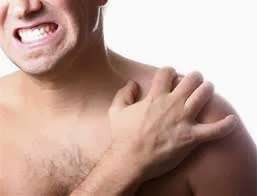Injury to the deltoid muscle or tendon that attaches to the collarbone (clavicle). Muscle, tendon and bone comprise a unit. The unit upholds the shoulder and allows its motion. A strain occurs at the unit’s weakest part. Strains are three types:
- Mild (Grade I)– slightly pulled muscle without tearing of muscle or tendon fibers. There is no loss of strength
- Moderate (Grade II)– tearing of fibers in the muscle, tendon or at the attachment to bone. Strength is diminished
- Severe (Grade III)– rupture of the muscle-tendon-bone attachment with separation of fibers. Severe strain requires surgical repair
Anatomy incorporated
- deltoid muscle and deltoid tendon in the collarbone area
- collarbone (clavicle)
- soft tissue encompassing the strain, including nerves, periosteum (covering to bone), blood vessels and lymph vessels
Signs and symptoms
Pain with motion or stretching, particularly throwing. Muscle spasm. Swelling in the collarbone area. Diminishment of strength. Crepitation (‘crackling’) feeling and sound when the injured area is pressed. Calcification of the muscle or tendon (visible with X-rays). Inflammation of the tendon sheath.
Origin
- extended overuse of the deltoid muscle-tendon unit
- single violent injury or force administered to the collarbone
Liability intensifies with
- contact sports
- weight-lifting
- throwing sports
- cardiovascular medical complication that decreases circulation
- medical history of bleeding disorder
- obesity
- poor nutrition
- previous shoulder or collarbone injury
- poor muscle conditioning
Prevention
- strengthen and condition appropriately before exercising
- warm-up before practice or competition
- use proper safeguarding equipment like shoulder pads whenever convenient
What to anticipate
- doctor’s diagnosis
- self-care during rehabilitation
- physical therapy (moderate or severe strain)
- surgery (severe strain)
Diagnostic measure
- personal observation of symptoms
- medical history and exam by a doctor
- X-rays of the collarbone area to identify fractures
Potential difficulties
- prolonged healing time if activity is hastily resumed
- susceptibility to re-aggravation
- unstable or arthritic shoulder following perpetual injury
- inflammation at the attachment to bone (periostitis)
- protracted impairment (sometimes)
Likely consequences
If a first-time injury, sufficient attention and adequate healing time before resuming normal activity should prevent permanent disability torn ligaments and tendons require as long to heal as a fractured bone. Average healing times are
- mild strain– two to 10 days
- moderate strain–10 days to six weeks
- severe strain–six to 10 weeks. If this is a recurrent injury, complications listed above are more prone to repeat
First aid
Initial treatment should be the conventional RICE (rest, ice, compression, elevation) technique.
Activity
- a moderate or severe strain requires a sling at least 72 hours
- return to normal activities gradually
Diet
Eat a balanced diet that containing extra protein like meat, fish, poultry, cheese, milk and eggs. Increase fiber and fluid intake to anticipate constipation that may decrease activity.
Rehabilitation
Start daily rehabilitation exercises when pain stops. Use ice massage for 10 minutes prior to exercise.






